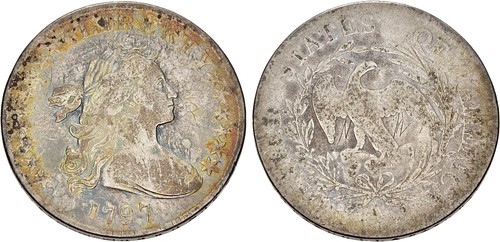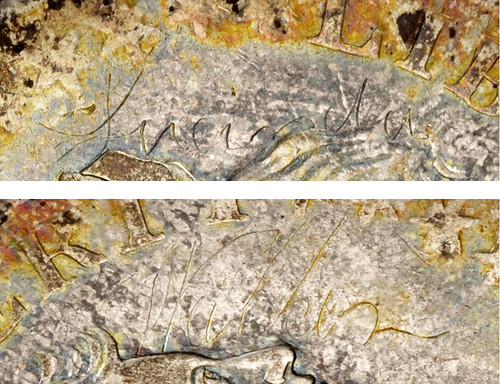
Classical Numismatic Group is offering an early dollar featuring some interesting graffiti. Here's the press release.
-Editor
Graffiti on 1797 Silver Dollar Opens Window into U.S. History
The discovery of a tiny set of letters hand-engraved on a vintage
U.S. silver dollar, and detective work by a sharp-eyed coin specialist, has opened a window into
a uniquely American tragedy – the Trail of Tears 1830-1850, when Native Americans of the
Cherokee nation and other tribes were forcibly relocated from their fertile ancestral homelands to
barren tracts of land west of the Mississippi.
The coin, a draped bust U.S. silver dollar dated 1797, 10 X 6 stars variety, graded Fine
Details, graffiti by NGC (6461819-003), is featured in Classical Numismatic Group LLC's
Electronic Auction 520, closing Wednesday, July 20, 2022.
 Jeff Rill, numismatist and auctioneer with Lancaster PA-based CNG, was cataloguing the
well-worn dollar when he noticed what looked like old graffiti on both sides of the coin.
Jeff Rill, numismatist and auctioneer with Lancaster PA-based CNG, was cataloguing the
well-worn dollar when he noticed what looked like old graffiti on both sides of the coin. I
carefully examined the graffiti, recording each letter singly, and then looked at what it spelled
out, Rill said.
The graffiti on the obverse read Lucinda Walker in neat, careful script. Curious, Rill
began researching known individuals of that name from the early 1800s, when a coin such as this
would have been in circulation.
He discovered that there was someone of this same name in the historical record – a
woman whose bloodline included both Native Americans and American settlers of European
stock. This Lucinda Walker, born Lucinda Taylor, was the daughter Chief Richard Fox Taylor of
the Cherokee Nation and his wife, Susan Taylor, of European ancestry.
Lucinda was born circa 1834 in the Old Cherokee Nation. She married a cousin, John
Osborn Walker circa 1854. According to the Eastern Cherokee application of her only child,
daughter Emily, born 19 November 1855, the family lived in the Tahlequah District (family #259
on the Cherokee Drennan Roll) where Lucinda died in 1859 at the age of 25. Her cause of death
at so early an age is not recorded.
While the graffiti on the obverse makes this an interesting possibility of the person's
identity, the graffiti on the reverse makes this identification more compelling, Rill said.
On the reverse, below the wings of the eagle, are the letters N and Mc. The half-sister of Lucinda's father was Nellie McDaniel, who married a white settler, James McDaniel.
To have the names and initials of two closely-related people who lived in the proper era on the
dollar, I believe, securely ties this coin to Lucinda Walker of the Cherokee Nation, Rill said.
How the coin came to be engraved with these two names cannot be known for certain,
but Rill had a plausible theory: It is possible that Lucinda's father's half-sister had this silver
dollar personalized and engraved with her married name as a wedding present upon Lucinda's
marriage, he said. A silver dollar at that time would have been a considerable amount of
money, roughly $35 in today's value, and so would have been a proper gift. Also, U.S. draped
bust silver dollars, minted 1795-1803, were quite rare and collectible even in the early 1800s.
Lucinda Taylor would have been about 4 years old when her father, Chief Richard Fox
Taylor, served as a conductor in the removal of the Cherokee Nation from their home in the
Mississippi Valley to the Oklahoma territory in the spring through winter of 1838. Conductors
were tribal leaders chosen to lead roughly 1,000-person detachments of Cherokees on the 770-
mile journey, which took more than 100 days to complete. Though born Cherokee, Taylor had
served as a volunteer guide in the U.S. military under Captain Gideon Morgan in 1814-1815
Creek War. He later served as Cherokee delegate to Washington D.C. and was elected Assistant
Principal Chief of the Cherokee Nation, serving from 1851-1853.
The Trail of Tears was a two-decade process, starting with President Andrew Jackson's
Indian Removal Act of 1830, by which more than 60,000 Native Americans of five different
nations were forcibly removed from their homelands in the rich Mississippi Valley to far more
barren lands hundreds of miles to the west. Little Lucinda would certainly have been part of that
episode, and it is difficult at this remove to think about what hardships she and her family might
have endured, even though her father, Chief Taylor, was favored by the U.S. government.
The coin is part of a larger consignment from the Hendin Family Collection, assembled
over decades by Aaron Hendin, MD (1918-1990), father of David Hendin, himself a collector of
ancient coins and author of the popular Guide To Biblical Coins series of numismatic books.
The Lucinda Walker Silver Dollar is in CNG Electronic Auction 520, which goes
live on CNG's popular website,
www.cngcoins.com, on Thursday, June 30, and closes three
weeks later, Wednesday, July 20. For further inquiries, contact Jeff Rill at
jeff@cngcoins.com.
Wayne Homren, Editor
The Numismatic Bibliomania Society is a non-profit organization
promoting numismatic literature. See our web site at coinbooks.org.
To submit items for publication in The E-Sylum, write to the Editor
at this address: whomren@gmail.com
To subscribe go to: https://my.binhost.com/lists/listinfo/esylum
Copyright © 1998 - 2024 The Numismatic Bibliomania Society (NBS)
All Rights Reserved.
NBS Home Page
Contact the NBS webmaster
|





